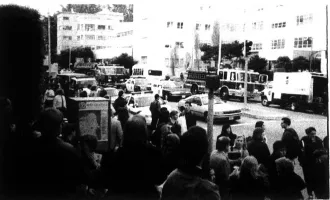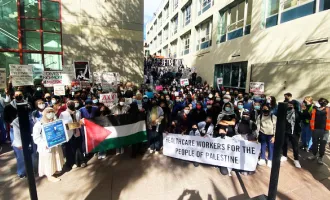UCSF Volunteers Inspire Budding Scientists in SF Schools
Do you want to gain teaching experience, inspire young students in science and contribute to the community by working with K-12 students? Science and Health Education Partnership (SEP) may be your answer.
SEP is a collaboration between UCSF scientists and San Francisco Unified School District (SFUSD) teachers to support high-quality science education for K-12 students.
SEP has been working with UCSF since 1987. SEP is also the main organizer for the upcoming Bay Area Science Festival (BASF), a 10-day celebration of the unique mix of science and technology in the Bay Area.
The third annual Bay Area Science Festival is scheduled to run from October 24 to November 2. The festival provides a wide range of science and technology activities — lectures, debates, exhibitions, concerts, plays and workshops — at a variety of locations throughout the Bay Area.
To find out more about volunteering for SEP, we talked with Julia Seaman, a graduate student in the PSPG (Pharmaceutical Sciences and Pharmacogenomics) program. She has participated in SEP for a number of years and shares some of her experiences here.
Synapse: Can you tell me about your experience with SEP? When did you start working? How did you get involved?
Seaman: I have volunteered with SEP every year I have been at UCSF (in my fourth year now). I found out about them from a flyer emailed from my program administrator advertising their info session.
I attended the session and signed up for the STAT (Science-Teacher Action Teams) program. They are incredibly organized and had meetings set up to help everyone get started with teaching and to meet our science and teacher partners.
I enjoyed it so much the first year that I signed up again when the applications came out each year. Last year, I was able to do a bigger program, called City Science, where I was in a fifth-grade classroom for a whole unit and then helped teach other SFUSD teachers the unit based on the in-classroom experience.
While it was much more intense, it was a lot more rewarding to be able to do extended lessons and concepts and (get) more teaching experience.
Synapse: What is your favorite part of working for SEP?
Seaman: My favorite aspect is working with the students. I have been in third- to fifth-grade classrooms, and it is awesome to see how excited they get when presented with new information.
They will ask questions about everything and anything, and try testing crazy predictions in order to understand the new info. My favorite was during learning about evaporation and salt solutions.
One student decided to see how microwaving changes the crystal structures remaining. Ultimately, it is great to watch when they suddenly grasp a new concept.
Synapse: Where do most of the SEP volunteers come from?
Seaman: I think most people are grad students and postdocs. I know that professional students are involved, but they generally have a more defined schedule, with classes and other duties that make volunteering during school hours more difficult.
Synapse: How do you think graduate students benefit from this partnership?
Seaman: I think grad students benefit in a lot of ways. Being up in front of a classroom to teach other people is actually pretty difficult, and requires a lot of planning, composure, speaking skills and the ability to react and improvise.
All of these skills are useful in other realms of life, like presentations. I think having to teach some more basic science concepts for elementary school (What is density? What is color? What is a cell?) is really helpful as an advanced scientist to remember the broader aspects of sciences.
It also helps the grad students remember how exciting science can be, when the kids finally understand something and can connect it to a bigger picture. Of course, it is nice to have a reason to get out of lab during the day.
Synapse: How do you think SFUSD students benefit from this partnership?
Seaman: For the SFUSD students, having SEP volunteers in class really helps expose them to different types of scientists, especially younger and less official-looking than they see during field trips.
The biggest lesson we try teach when we are there is a way of thinking about how to approach scientific questions and experiments.
A big part that we emphasize is that experiments can fail or have unexpected results, and we, as the scientists and teachers, may not always be correct in our own predictions, which is OK. This, of course, is a lesson many grad students and postdocs know well.
Synapse: What is it like working with SFUSD students?
Seaman: Working with the students is awesome. It can be tough, and you need to be prepared for the age group you are working with. For example, Kindergarten students cannot read much, or at all, and may not be able to sit still for any extended time.
Fifth-graders, on the other hand, are much more independent and will be able to do a lot more in the same time period.
Also, each classroom has its own dynamic, dictated by the teachers, for how to get students’ attention (clapping, singing, bells, etc.) and how to give out merits or demerits.
Every classroom I have been to has been excited to see me whenever I arrive — and always wondering what we would be doing that day.
Synapse: What is it like working with UCSF scientists?
Seaman: Working with the other scientists is fun. SEP has allowed me to meet a whole group of people from across UCSF campuses that I would have never run into. It is great to hear about the science and labs across campus that I don’t normally interact with. Everyone I’ve met has also been enthusiastic about the SEP program, so working together and planning has always been easy.
SEP is recruiting now! Check out its website. http://biochemistry.ucsf.edu/programs/sep/school-programs.html


